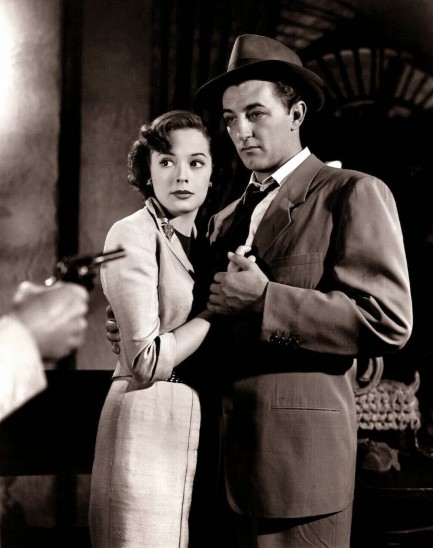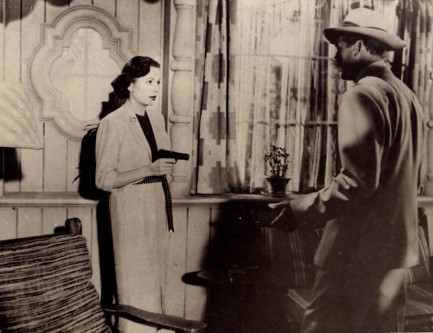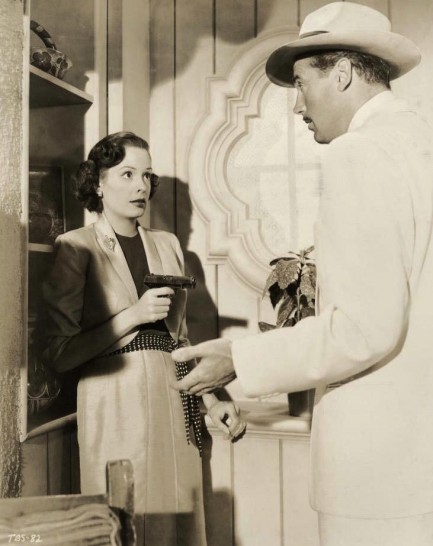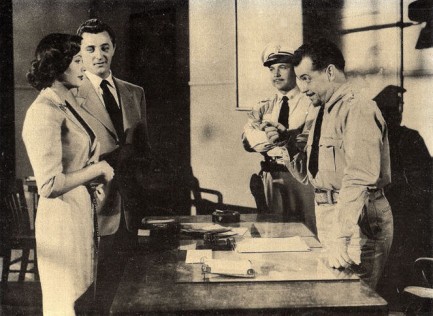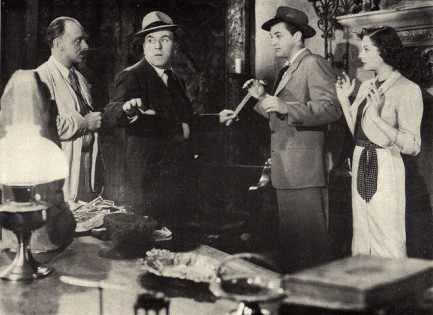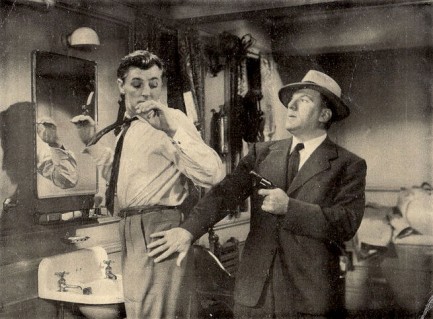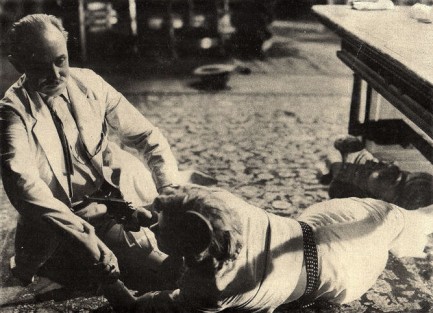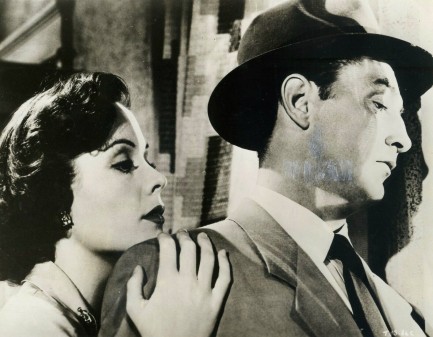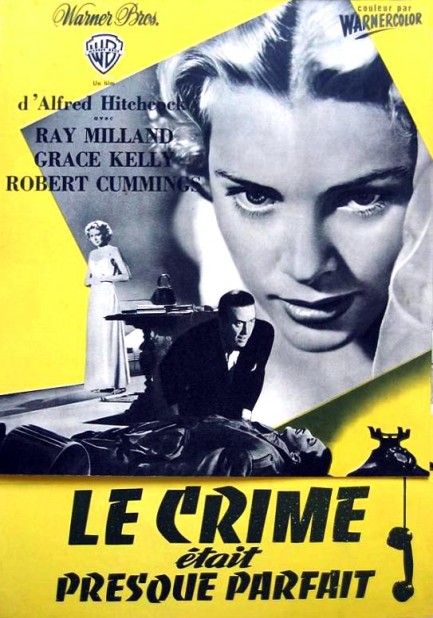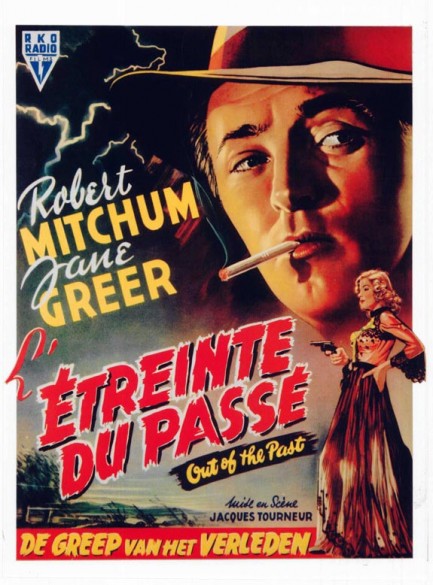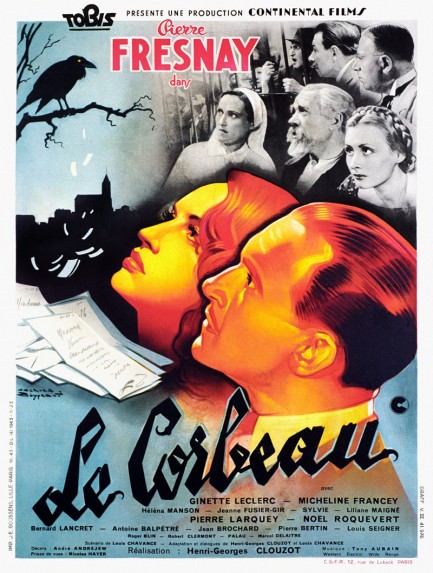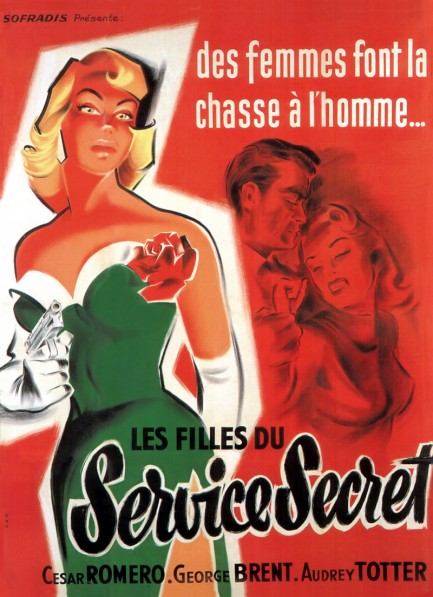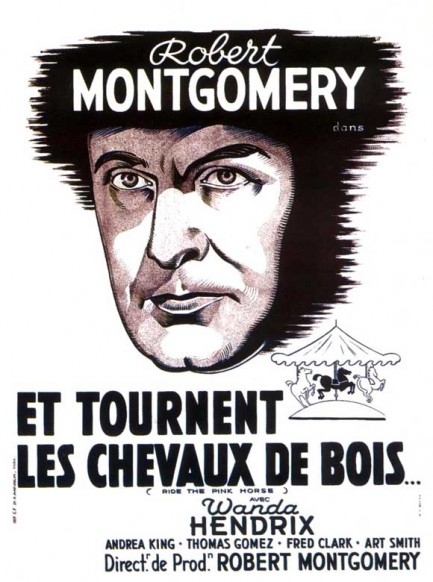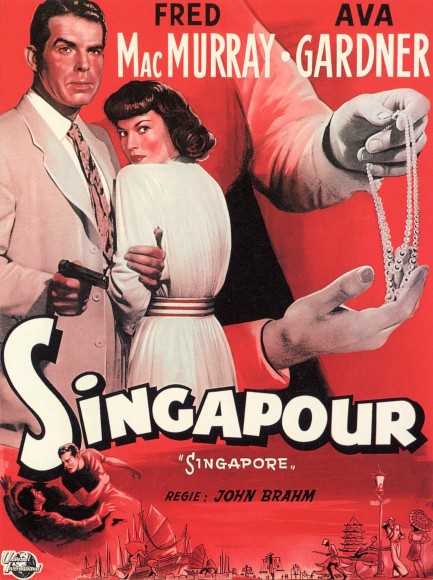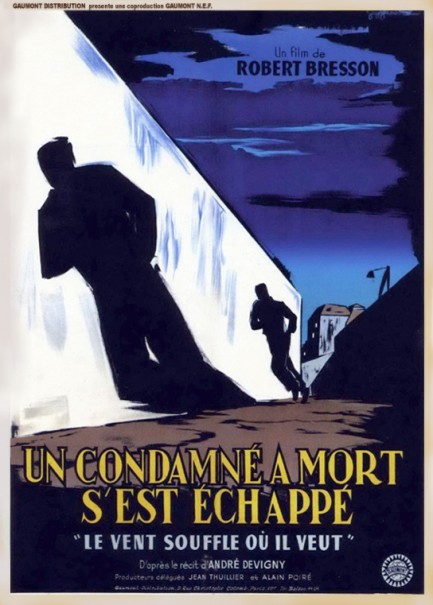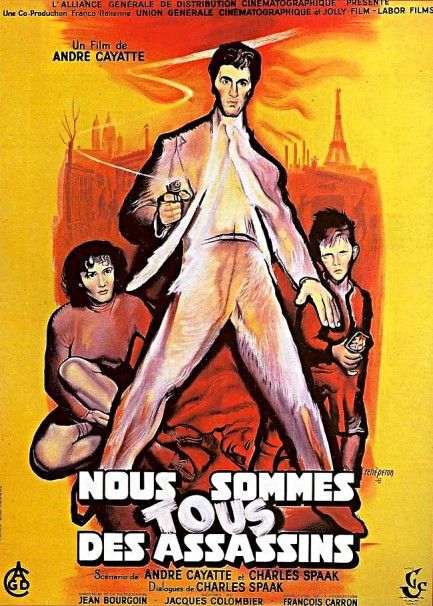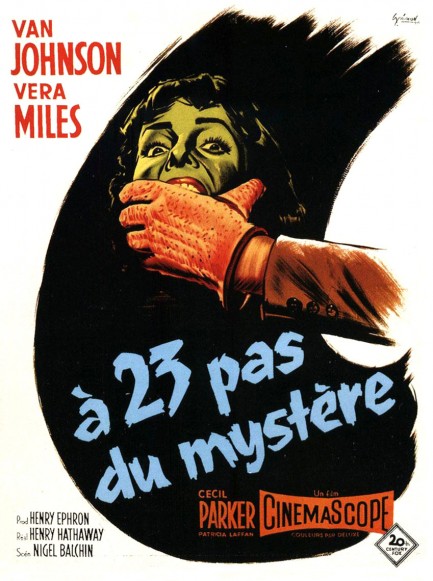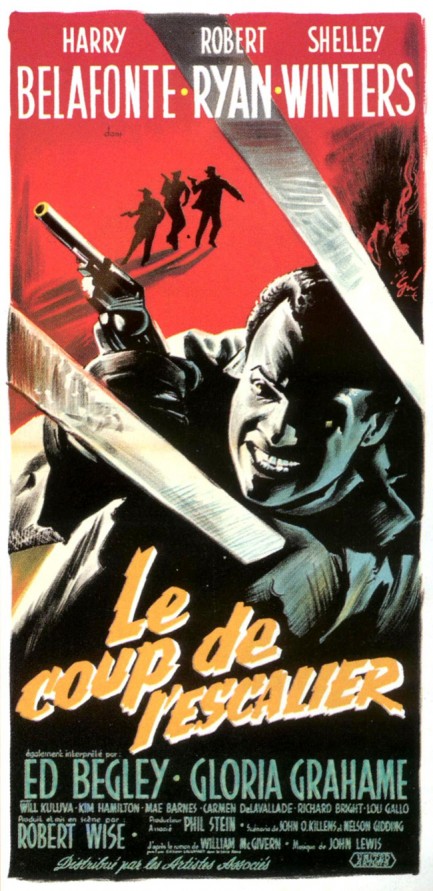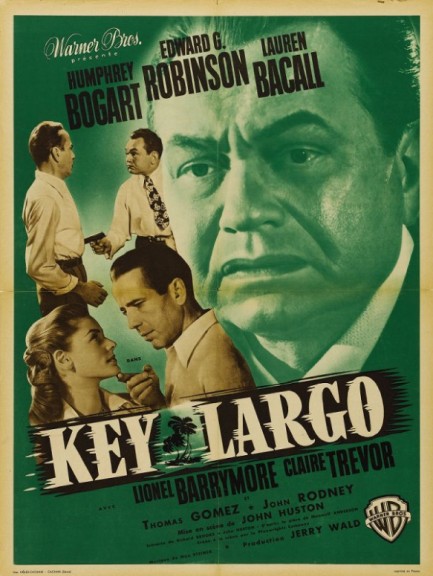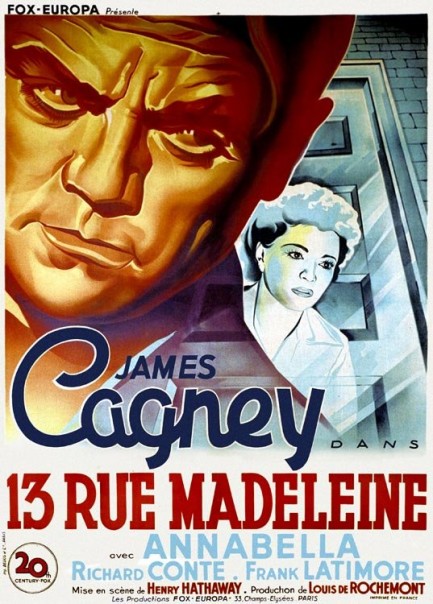 There's nowhere to swim. But there will be. Eventually. 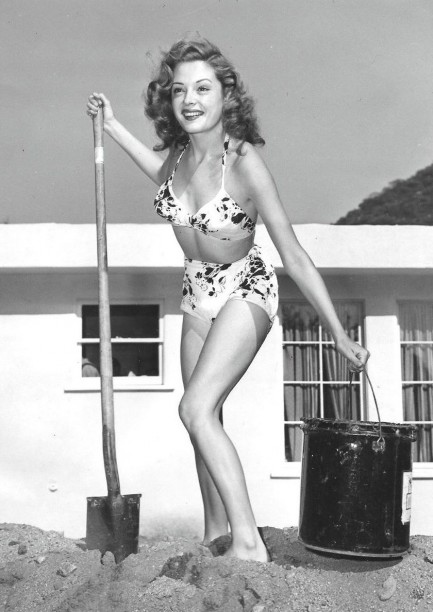
We said we'd show you an image of Jane Greer without a gun, and here she is, all dressed down with no place to swim. This is a really lovely photo, we think, showing her in a different light from the femme fatale we all know and love. If you haven't seen those photos of her in murder mode, just start at this post. You'll assuredly be seeing Greer here again.
 Once you get into the habit it's hard to stop. 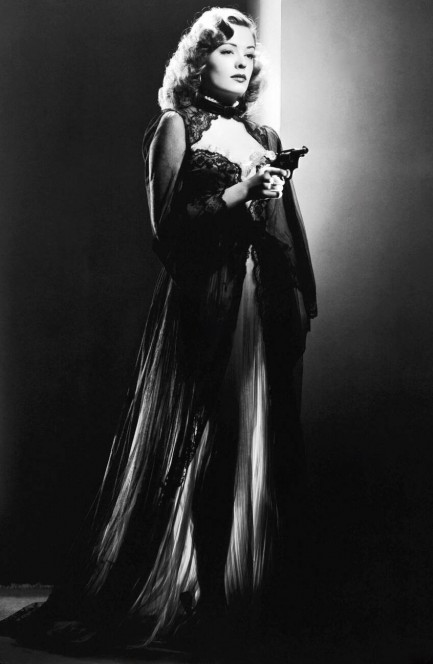
It's Jane Greer again, in yet another pistol packing promo image from her mandatory 1947 film noir Out of the Past. This makes the third we've posted. Here she's in a different outfit and on a different set than the other two. See those previous images here and here, and check out another nice armed promo of her from The Big Steal here. We'll share an image of her without a gun soon. Yes, she actually made some, amazing as it seems. Also, watch Out of the Past. It's one of the most visually gorgeous film noirs ever.
 It doesn't show on my face but I'm enjoying this immensely. 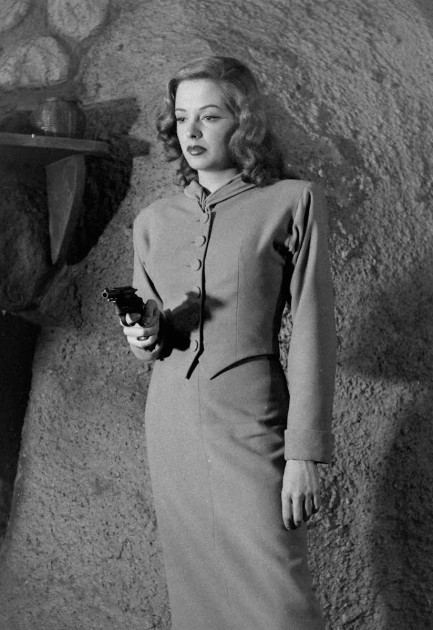
Jane Greer and guns. There are quite a few photos of her armed. This one was made when she was filming Out of the Past, but it doesn't depict the iconic moment when she shot Steve Brodie. She shot him from the front door. Here she's by the fireplace, about where Brodie was when she ventilated him. So we guess RKO Radio Pictures made an entire set of Greer with a gun, complete with wardrobe changes. She looks good in all of them. See her armed and dangerous in three production photos—two from Out of the Past and one from The Big Steal—here, here, and here.
 The toughest case to solve is a case of amnesia. 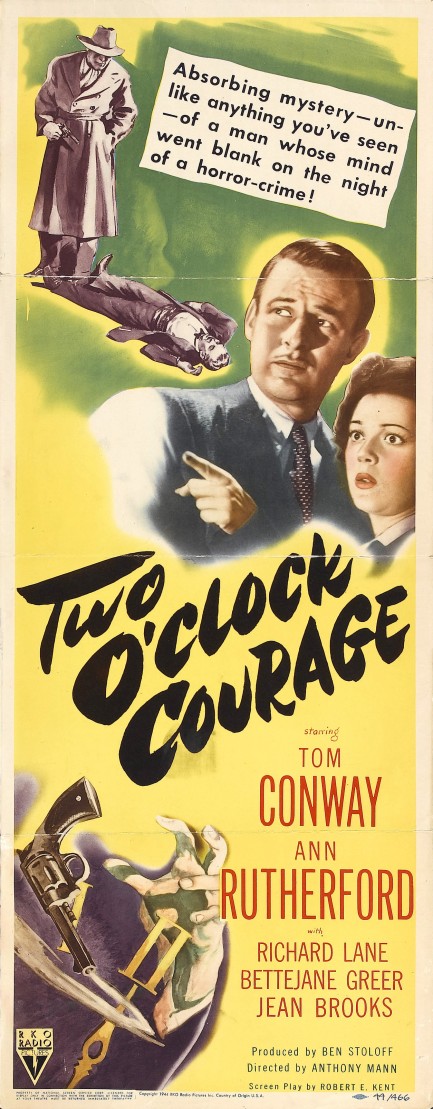
The poster above was made to promote the mystery Two O'Clock Courage, an interesting little noir-adjacent obscurity released today in 1945. It was directed by Anthony Mann of T-Men fame, and stars Tom Conway as a hapless everyman and Ann Rutherford as a cabbie who almost runs him over, but instead takes him under her wing. Conway needs help, you see, because he's been bonked over the head, and has no clue by whom or why. In fact, he doesn't remember anything before meeting Rutherford. Everything is a big fat blank. With his brain back to factory reset, he's a nice enough guy, but he soon learns that Rutherford found him near the scene of a murder. Did he have anything to do with it? He fears he might have. He and Rutherford pair up to sleuth their way to a solution, with cops and the press underfoot all the while.
The movie, while a mystery, also aims for laughs in the style of The Thin Man, with quips, wacky secondary characters, Bettejane Greer (Jane Greer) comically overacting the effects of alcohol, and an inspector who's entirely too willing to defer authority to nosy amateurs. Maybe it was uproarious in its day, but in our day it's a bit tedious. The problem is Conway's stumbling, stammering performance. A little more agency and competence would have played better, in our opinion. His all thumbs persona isn't a dealbreaker, though, thanks to Rutherford's presence. The two even manage to generate a few legit chuckles. As for the mystery, they're pretty bad as sleuths, but they eventually solve it, because with respect to cinematic amnesia you can always count on one thing—it's easy come, easy go.
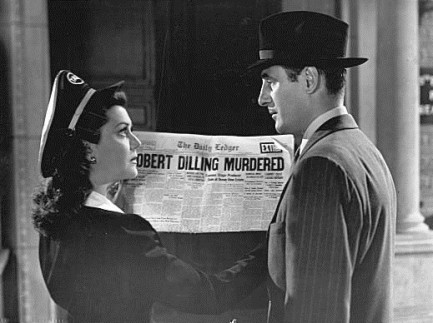 So you really have total and complete amnesia? So you really have total and complete amnesia?
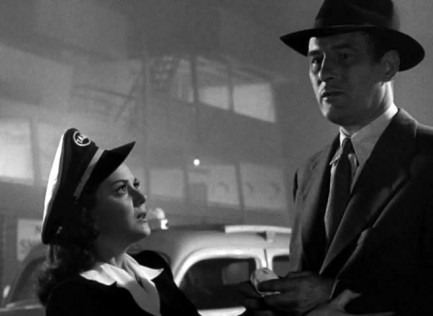 I guess you don't remember, but I've let you ride in my cab, like, hundreds of times and you owe me probably three grand. Cash only, please. I guess you don't remember, but I've let you ride in my cab, like, hundreds of times and you owe me probably three grand. Cash only, please.
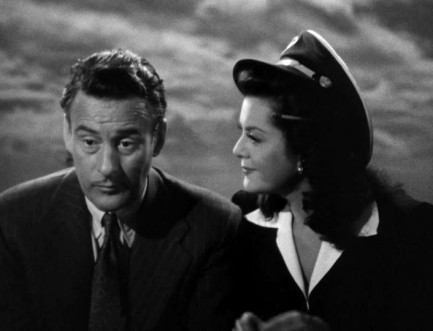 Oh, also we've had dozens of wild, carnal nights together. Since you forgot we better do all those again. Oh, also we've had dozens of wild, carnal nights together. Since you forgot we better do all those again.
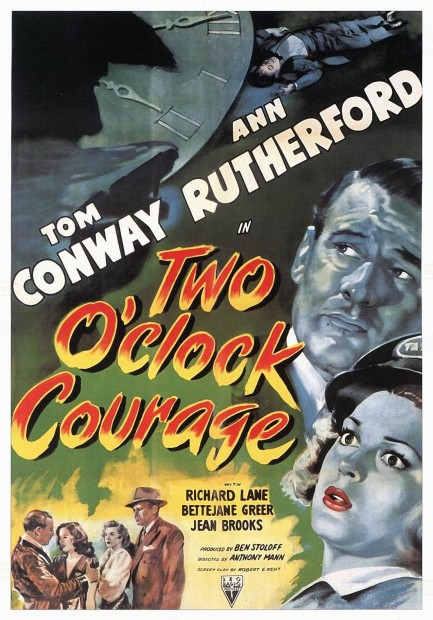
 What's being stolen? A previous movie's most successful ideas. 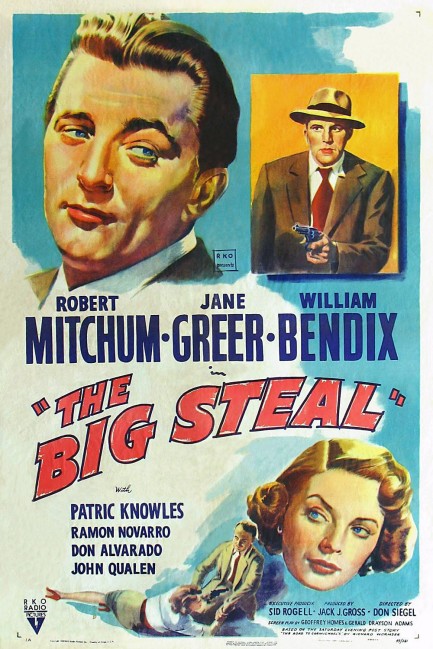
Every Hollywood star has that brief moment when they're invincible at the box office, but it seems as if Robert Mitchum, more than most others, was a guy who maintained his power for many years. When The Big Steal came out he'd already run the gauntlet of a drug bust, jail time, and the public repentance circuit, and seemed to emerge unscathed. The executive brains at RKO decided to match teflon Rob with Jane Greer in an attempt to replicate the pair's runaway success in the film noir monument Out of the Past. This time the studio went for a lot of banter and not much in the way noir style, as Mitchum plays an army lieutenant accused of a payroll robbery who pursues the real thief Patric Knowles through Mexico. Greer plays Knowles' fiancée, who he cold-heartedly divested of two-thousand bucks, because thieves are just a little more pragmatic than they are romantic.
The movie is fueled by that Mitchum/Greer chemistry, plus high speeds, resort wardrobe, wry looks, and the Out of the Past memories of movie audiences. Greer brandishes a gun again, just as in that seminal sequence in Out of the Past. Mitchum has a desperate fistfight, just as in Out of the Past. All of this retreading is supported by visually helpful location shooting in Veracruz and other areas of Mexico. The end result is a pleasant little chase film that's even comical at times. Or maybe the laughs came from our dark senses of humor. For example, you know how car pursuits sometimes go right through flocks of chickens, but the chickens never get hurt? In this movie one actually gets run over—at least if the numerous feathers drifting in the car's wake were any indication. That really amused us. Also nearly flattened were goats, a few cows, mules, children, and middle-aged ladies. In fact, all the near misses felt like a running gag about how Americans are always in a hurry.
Other aspects of the movie are equally tongue-in-cheek, including Mitchum's ugly-American stabs at Spanish, but however lightweight this is at times, in the end it's still categorized as a thriller, which means it needs to make pulses race. We wouldn't say it fully achieves that requirement, but it isn't bad either. Mitchum gonna Mitchum, and that's all a studio needed at this moment in time to make a movie work. He'd go on to headline Where Danger Lives, Angel Face, and a long string of good-to-middling dramas and noirs, all the way up to his other cinematic monuments, 1955's The Night of the Hunter and 1962's Cape Fear. The Big Steal is an okay flick, but its true value may be that it shows what the Mitchum charm can do for material that doesn't even deserve him. It premiered in the U.S. today in 1949.
 They say white is appropriate only for your first shooting, but you know what? Screw convention. 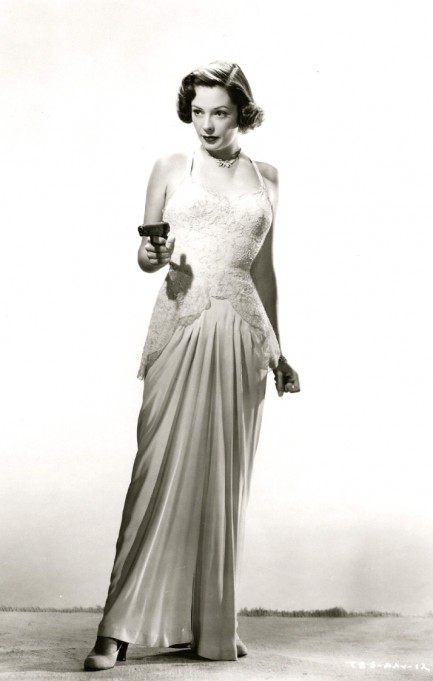
We last saw Jane Greer using a gun in a promo image we shared from the 1947 film noir classic Out of the Past, and here she is waving one around again in a shot made when she starred in 1949's The Big Steal, which reunited her with Out of the Past leading man Robert Mitchum. We haven't seen The Big Steal, but it's on the list now.
 Better late than never is our motto around here. 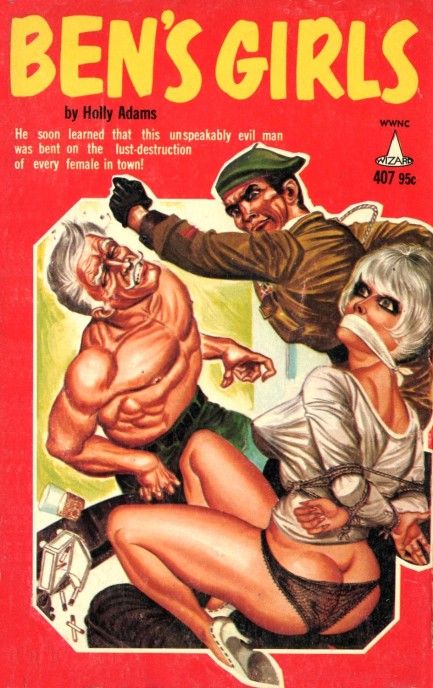
We're finally getting back to paperback artist Gene Bilbrew, whose odd style, with its scantily clad women and their muscular butts has become collectible in recent years. We didn't get it at first, but like a lot of art, once you're exposed to it regularly you begin to appreciate its unique qualities. There's clear intent in Bilbrew's work, a deliberate attempt to approach illustration from a different angle, and we've grown to understand that his cartoonish, chaotic, often humorous, and often bondage themed aesthetic is purposeful. In fact, his imagery has become so intertwined with the bdsm scene that in 2019 the National Leather Association International established an award named after Bilbrew for creators of animated erotic art. While it's not exactly a Pulitzer Prize, the point is that Bilbrew's bizarre visions keep gaining wider acceptance. So for that reason we've put together another group of his paperback fronts. You can see more of them here, here, and here, and you can see a few rare oddities here, here, and here. 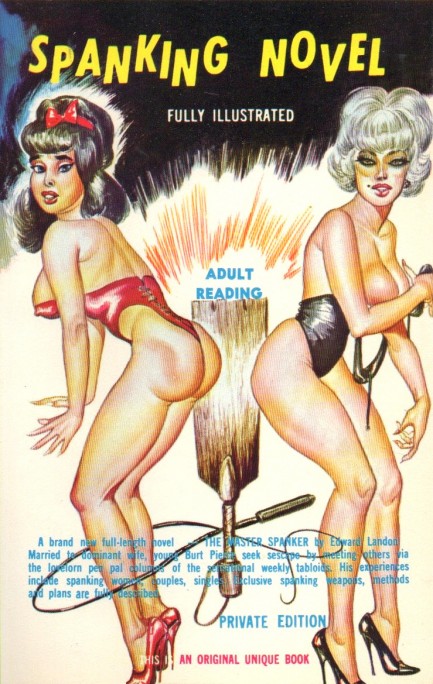 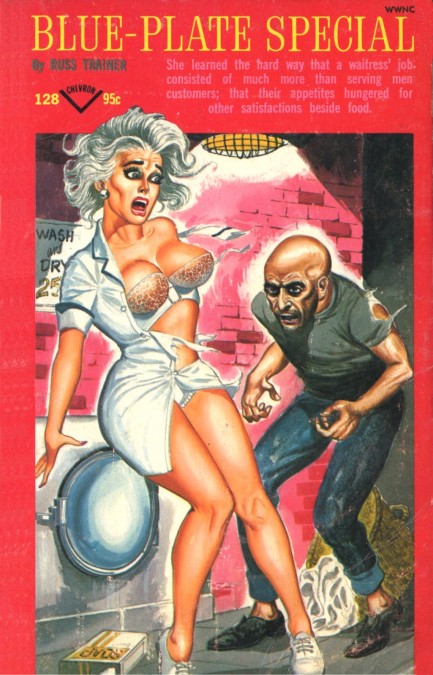 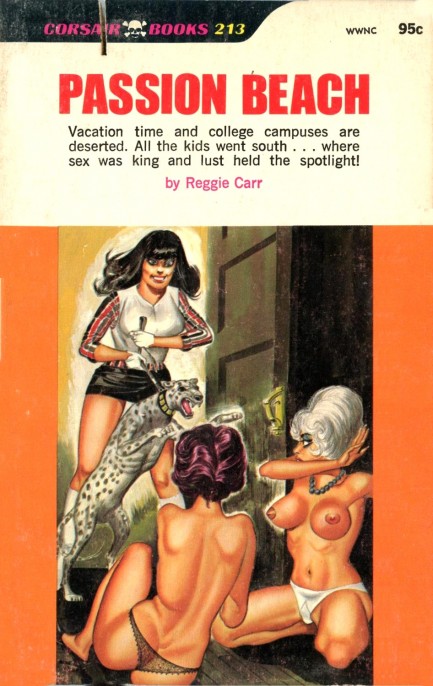 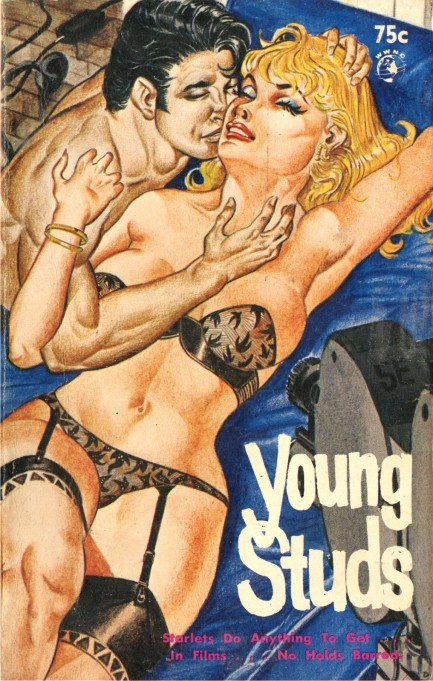 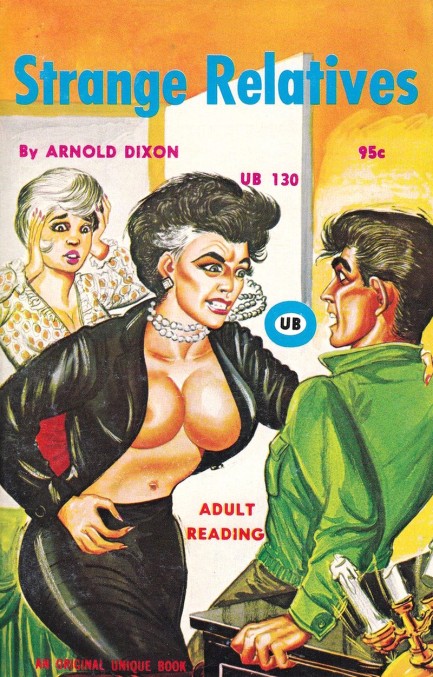 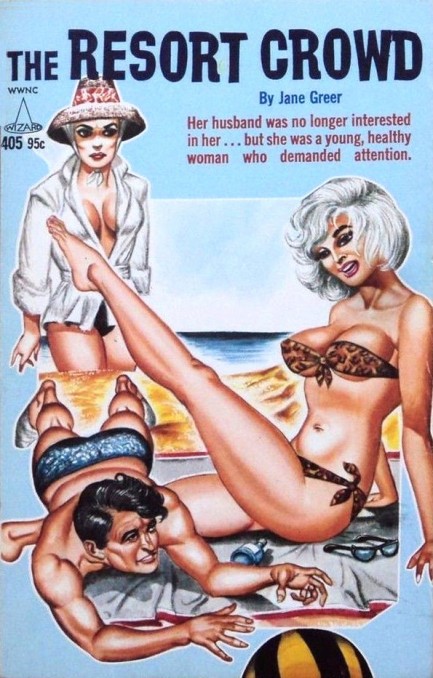 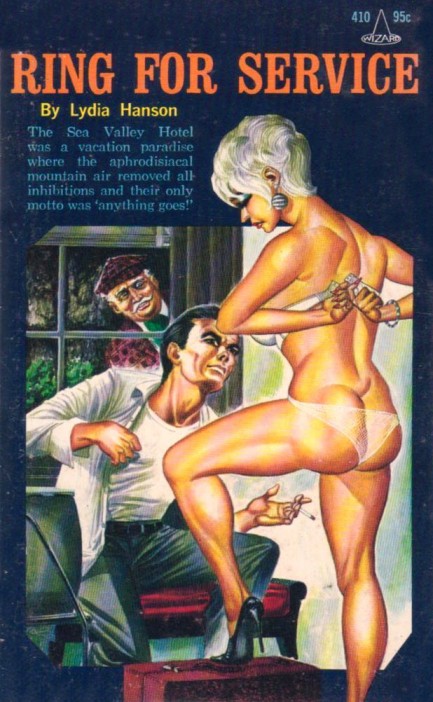  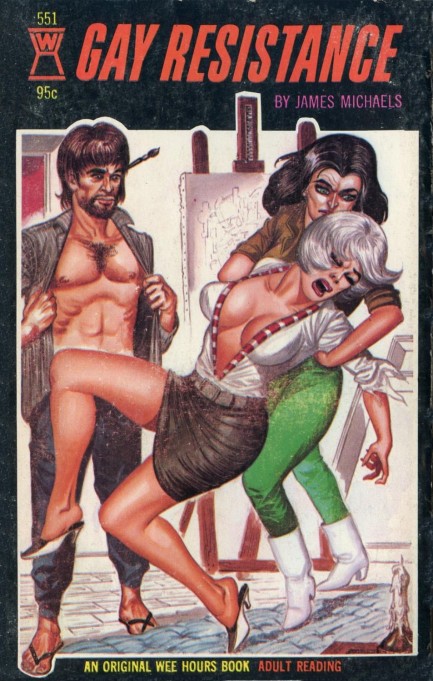 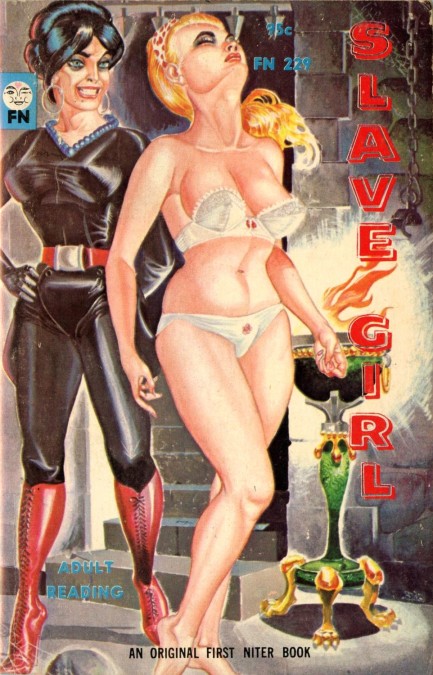 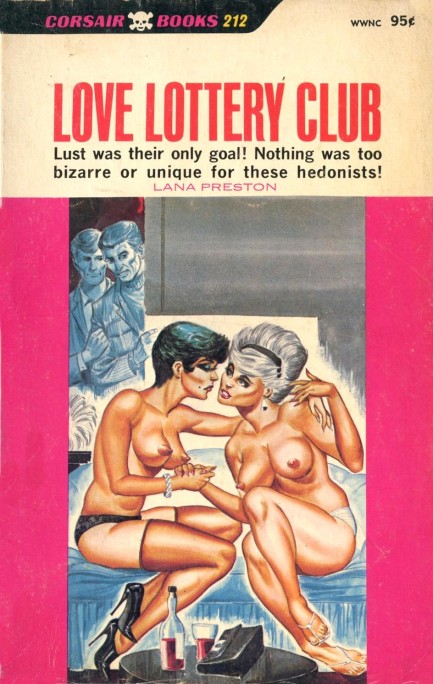 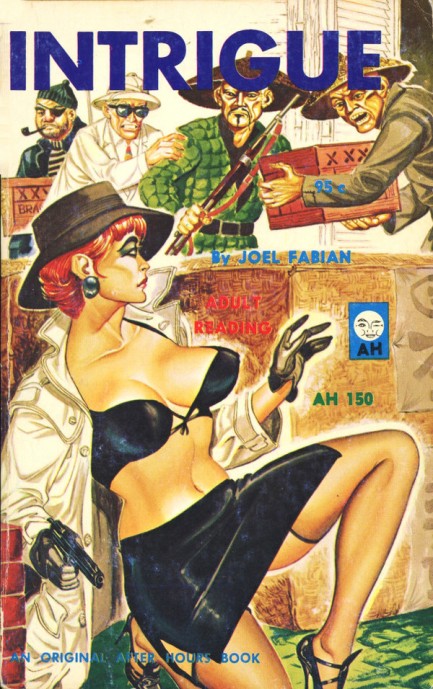 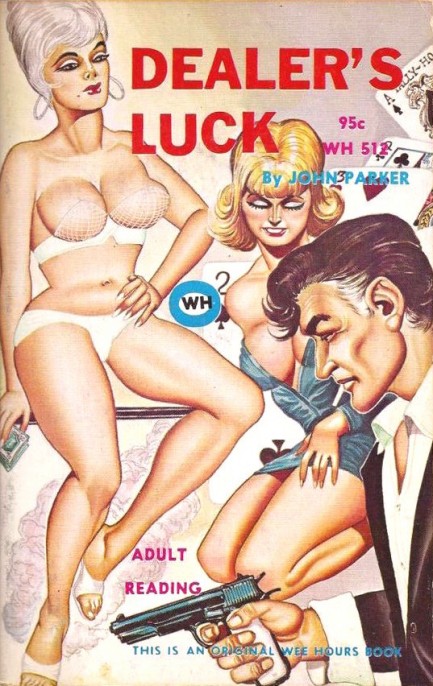 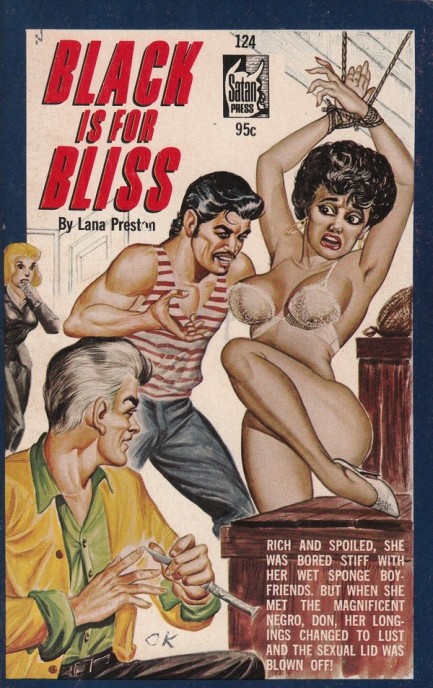  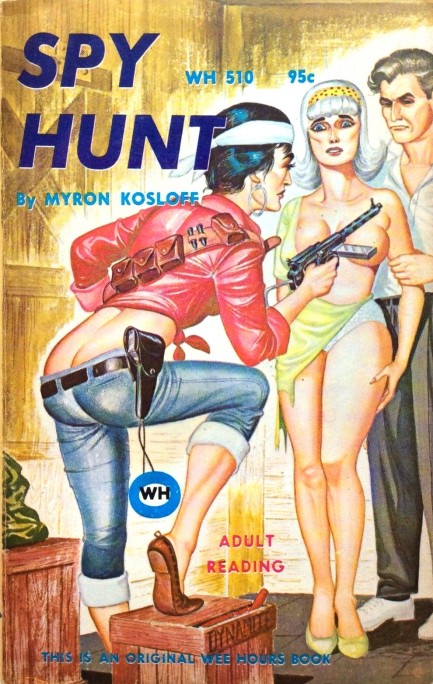 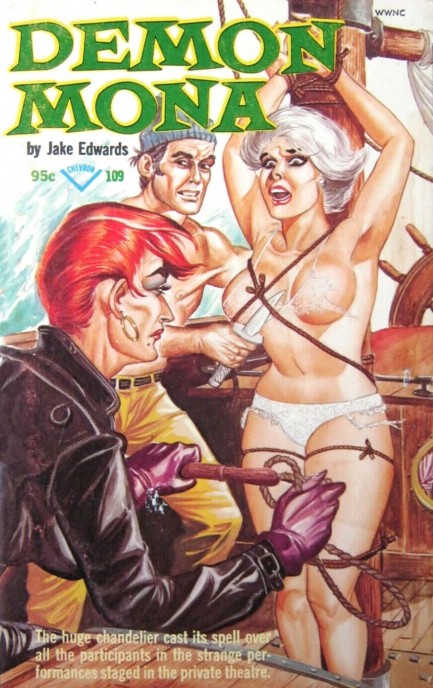 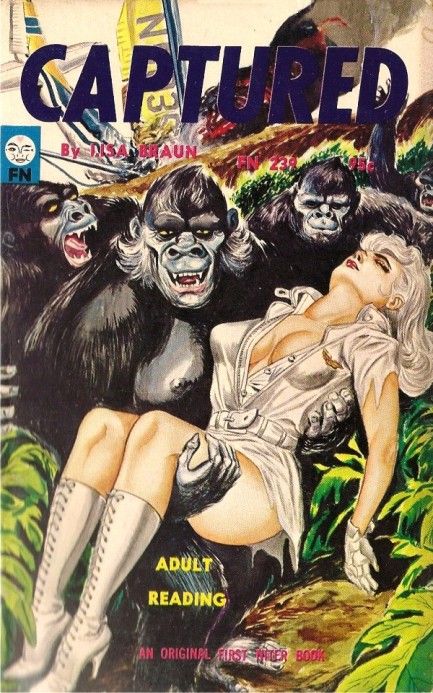 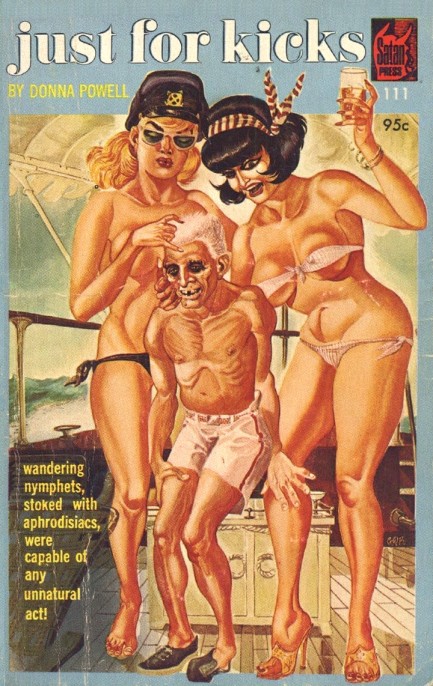
 Like Shakespeare wrote, what's past is prologue. 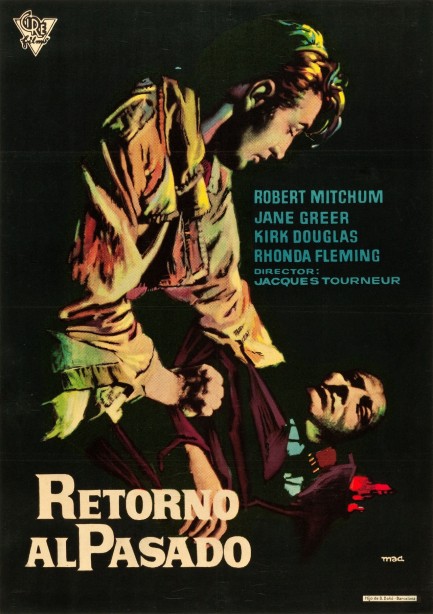
This unusual poster was made to promote the Spanish run of Retorno al pasado, a movie better known as Out of the Past. The title says it all. A man who thinks he's left his sordid past behind sees it rear its ugly head and threaten to ruin the good future he's planned for himself. Starring Robert Mitchum, Jane Greer, and Kirk Douglas, this is one of the top noir thrillers, in our opinion. Certainly it's one of the most beautifully shot, thanks to director Jacques Tourneur and cinematographer Nicholas Mesuraca. Like the poster art by Macario Gomez, the film is richly textured and lushly black, which makes for a nice sense of gathering danger, especially in the pivotal fight sequence about forty minutes in. Plus it has the always compelling Mexico connection used by many excellent noirs, as well as nice location shooting around Lake Tahoe and Reno. Highly recommended, this one. After opening in the U.S. in November 1947 it had its Spanish premiere in Madrid today in 1948.
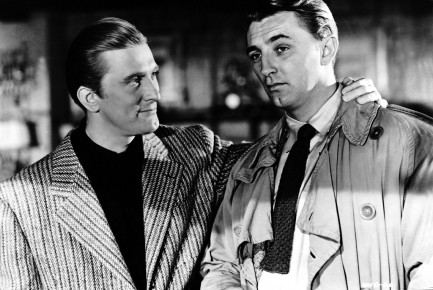 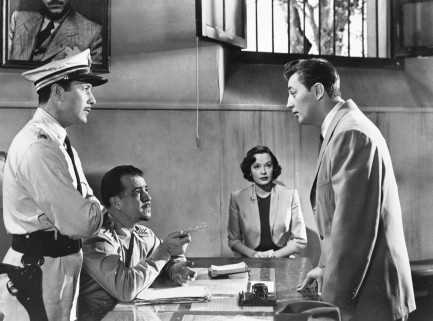  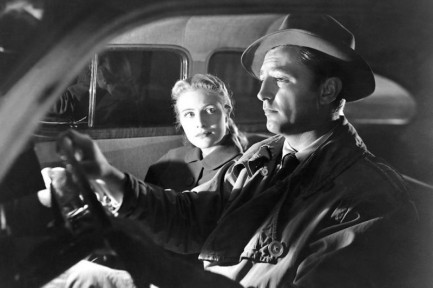 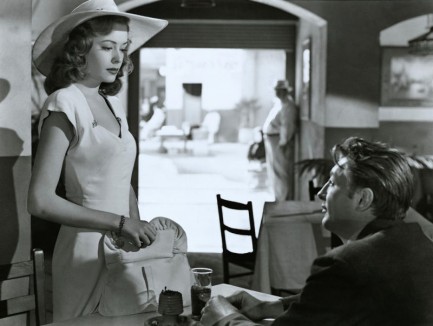 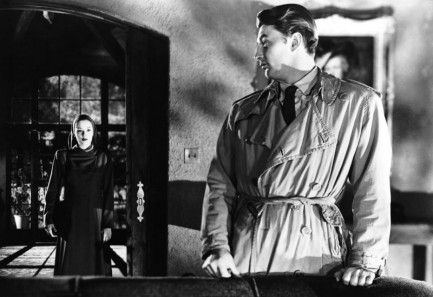 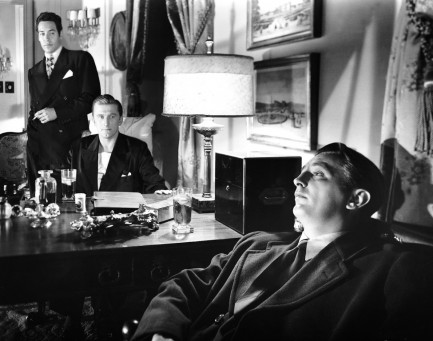 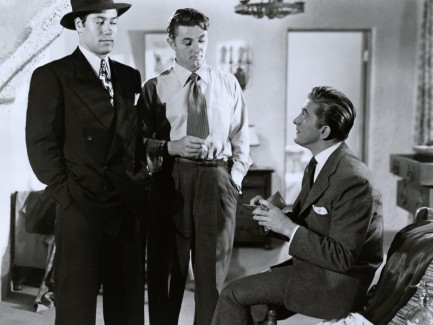
 Nothing to fear but Greer herself. 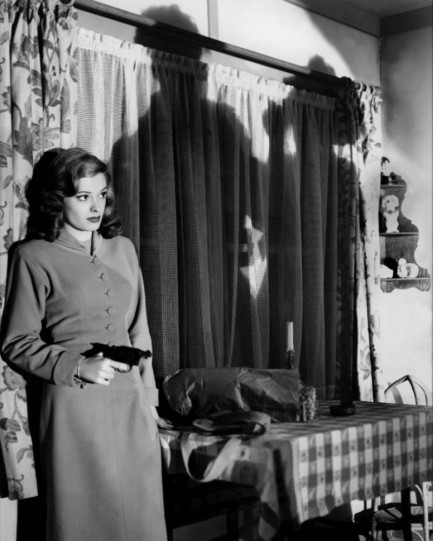
This awesome promo photo comes from Jacques Tourneur’s iconic 1947 film noir Out of the Past, in which Jane Greer plays Kathie Moffat, one of history’s greatest femmes fatales. Here she watches Robert Mitchum and Steve Brodie in a fistfight, planning all along to decide the situation with a bullet.
 Only the good go to sleep at night. 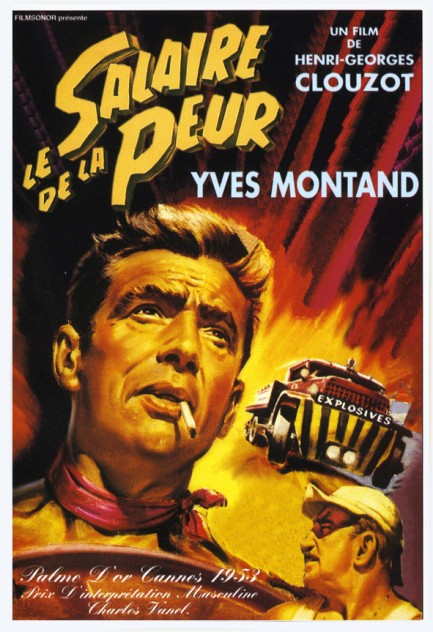
The French coined the term film noir, so it seems only fitting to feature a collection of French posters celebrating the genre. Above and below are fifteen examples promoting films noir from France, Britain, and the U.S., representing some of the best ever produced within the art form, as well as some less celebrated examples that we happen to love. Of those, we highly recommend seeing Le salaire de la peur, for which you see the poster above, and Ride the Pink Horse, below, which played as Et tournent les chevaux de bois in France. Just a word about those films (and feel free to skip ahead to the art, because really, who has time these days to listen to a couple of anonymous internet scribes ramble on about old movies?). 1953’s Le salaire de la peur is about a group of men stranded in an oil company town in the mountains of Latin America. In order to earn the wages to get out, four of them agree to drive two trucks filled with nitroglycerine over many miles of dangerous terrain. The idea is to use the chemicals to put out a raging oil well fire that is consuming company profits by the second, but of course the film is really about whether the men can even get there alive. Le salaire de la peur was critically praised when released in Europe, but in the U.S., political factions raised their ugly heads and got censors to crudely re-edit the prints so as to reduce the movie’s anti-capitalist (and by extension anti-American) subtext. The movie was later remade by Hollywood twice—once in 1958 as Hell’s Highway, and again in 1977 as Sorcerer. The original is by far the best.
1947’s Ride the Pink Horse is an obscure noir, but a quintessential one, in our opinion. If many noirs feature embittered World War II vets as their anti-heroes, Robert Montgomery’s Lucky Gagin is the bitterest of them all. He arrives in a New Mexico border town on a quest to avenge the death of a friend. The plot is thin—or perhaps stripped down would be a better description—but Montgomery’s atmospheric direction makes up for that. Like a lot of mid-century films featuring ethnic characters, the most important one is played by a white actor (Wanda Hendrix, in a coating of what looks like brown shoe polish). It's racist, for sure, but within the universe of the film Lucky Gagin sees everyone around him only as obstacles or allies—i.e., equals within his own distinct worldview. So that makes up for it. Or maybe not. In any case, we think Ride the Pink Horse is worth a look. Thirteen more posters below.
|
 |

The headlines that mattered yesteryear.
2003—Hope Dies
Film legend Bob Hope dies of pneumonia two months after celebrating his 100th birthday. 1945—Churchill Given the Sack
In spite of admiring Winston Churchill as a great wartime leader, Britons elect
Clement Attlee the nation's new prime minister in a sweeping victory for the Labour Party over the Conservatives. 1952—Evita Peron Dies
Eva Duarte de Peron, aka Evita, wife of the president of the Argentine Republic, dies from cancer at age 33. Evita had brought the working classes into a position of political power never witnessed before, but was hated by the nation's powerful military class. She is lain to rest in Milan, Italy in a secret grave under a nun's name, but is eventually returned to Argentina for reburial beside her husband in 1974. 1943—Mussolini Calls It Quits
Italian dictator Benito Mussolini steps down as head of the armed forces and the government. It soon becomes clear that Il Duce did not relinquish power voluntarily, but was forced to resign after former Fascist colleagues turned against him. He is later installed by Germany as leader of the Italian Social Republic in the north of the country, but is killed by partisans in 1945.
|

|
|

It's easy. We have an uploader that makes it a snap. Use it to submit your art, text, header, and subhead. Your post can be funny, serious, or anything in between, as long as it's vintage pulp. You'll get a byline and experience the fleeting pride of free authorship. We'll edit your post for typos, but the rest is up to you. Click here to give us your best shot.

|
|








 So you really have total and complete amnesia?
So you really have total and complete amnesia? I guess you don't remember, but I've let you ride in my cab, like, hundreds of times and you owe me probably three grand. Cash only, please.
I guess you don't remember, but I've let you ride in my cab, like, hundreds of times and you owe me probably three grand. Cash only, please. Oh, also we've had dozens of wild, carnal nights together. Since you forgot we better do all those again.
Oh, also we've had dozens of wild, carnal nights together. Since you forgot we better do all those again.


